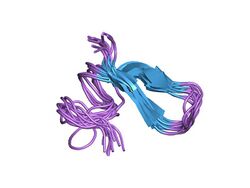Biology:Paralytic peptides
From HandWiki
| GBP_PSP | |||||||||
|---|---|---|---|---|---|---|---|---|---|
 Structure of a paralytic peptide from an insect, Manduca sexta | |||||||||
| Identifiers | |||||||||
| Symbol | GBP_PSP | ||||||||
| Pfam | PF02425 | ||||||||
| InterPro | IPR003463 | ||||||||
| SCOP2 | 1b1v / SCOPe / SUPFAM | ||||||||
| OPM superfamily | 156 | ||||||||
| OPM protein | 2eqt | ||||||||
| |||||||||
Paralytic peptides are a family of short (23 amino acids) insect peptides that halt metamorphosis of insects from larvae to pupae. These peptides contain one disulphide bridge. The family includes growth-blocking peptide (GBP) of Mythimna separata (Oriental armyworm) and the paralytic peptides from Manduca sexta (tobacco hawkmoth), Heliothis virescens (noctuid moth), and Spodoptera exigua (beet armyworm) [1] as well as plasmatocyte-spreading peptide (PSP1).[2]
References
- ↑ "Isolation and identification of paralytic peptides from hemolymph of the lepidopteran insects Manduca sexta, Spodoptera exigua, and Heliothis virescens". Journal of Biological Chemistry 266 (20): 12873–7. July 1991. doi:10.1016/S0021-9258(18)98775-2. PMID 2071576.
- ↑ "Structure of the insect cytokine peptide plasmatocyte-spreading peptide 1 from Pseudoplusia includens". Journal of Biological Chemistry 274 (8): 4493–6. February 1999. doi:10.1074/jbc.274.8.4493. PMID 9988679.
 |

